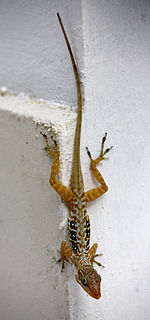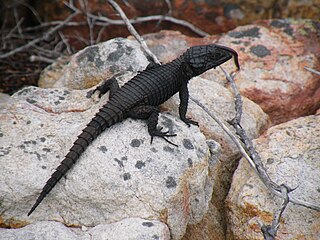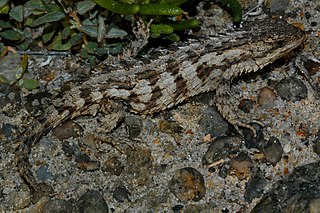
The genus Cordylus includes a wide variety of small- to medium-sized spiny lizards from Africa, collectively called girdle-tailed or girdled lizards. All are diurnal and ovoviviparous. Most species are rupicolous (rock-dwelling), while a few species are arboreal or live in burrows. They defend themselves with osteoderms and by quickly retreating into rock crevices or burrows. Many species live in groups and males defend territories.

The armadillo girdled lizard, also commonly known as the armadillo lizard, the Golden-armadillo lizard, or the armadillo spiny-tailed lizard, is a species of lizard in the family Cordylidae. The species is endemic to desert areas along the western coast of South Africa. In 2011, it was moved to its own genus based on molecular phylogeny, but formerly it was included in the genus Cordylus.

The sungazer, also known as the giant girdled lizard, giant dragon lizard, or giant zonure, is the largest species of the Cordylidae, a family of lizards from sub-Saharan Africa. This threatened species is endemic to Highveld grasslands in the interior of South Africa. In 2011, it was assigned to the new genus Smaug, along with seven other species previously belonging to the genus Cordylus, based on a comprehensive molecular phylogeny of the Cordylidae.
Hemicordylus nebulosus is a species of lizard in the Cordylidae family. It is endemic to South Africa.
Mitchell's flat lizard is a species of lizards in the family Cordylidae.

The Transvaal girdled lizard or Reichenow's spiny-tailed lizard is a very flattened girdled lizard from northeastern South Africa, Swaziland, and southeastern Botswana. It prefers rock outcrops in open grassland and feeds on small arthropods, especially beetles.

Warren's girdled lizard is a species of relatively large, flattened lizard in the family Cordylidae. The species is native to Southern Africa.
The Dwarf Karoo girdled lizard is a species of lizard in the family Cordylidae. It is a small, spiny lizard found in South Africa.

Iguana is a genus of herbivorous lizards that are native to tropical areas of Mexico, Central America, South America, and the Caribbean. The genus was first described in 1768 by Austrian naturalist Josephus Nicolaus Laurenti in his book Specimen Medicum, Exhibens Synopsin Reptilium Emendatam cum Experimentis circa Venena. Two species are placed in the genus, the green iguana, which is widespread throughout its range and a popular pet, and the Lesser Antillean iguana, which is native to the Lesser Antilles. Genetic analysis indicates that the green iguana may comprise a complex of multiple species, some of which have been recently described, but the Reptile Database considers all of these as subspecies of the green iguana.

Anolis oculatus, the Dominica anole, Dominican anole or eyed anole, is a species of anole lizard. It is endemic to the Caribbean island of Dominica, where it is found in most environments. The species is found in a diverse range of color forms, which one herpetologist once classified as four subspecies, which most other scientists did not recognise because the forms gradually inter-grade with one another. Two later researchers have instead promoted the "ecotypes" concept, hypothesizing the color forms are maintained by the ecological conditions of the surrounding environment, despite being genetically indistinguishable. The morphology of some traits is subject to clinal variation, gradually changing from one side of the island to the other, or from sea level to the hilltops. The ground color ranges from pale tan or yellow to deep green or brown. It also has patterned markings that range from light-colored speckling to complex marbled patterns, and some populations also have large black-ringed "eye" spots on their flanks.

Cordylus niger, the black girdled lizard, is a medium-sized lizard restricted to Table Mountain on the Cape Peninsula and a second, isolated population near Langebaan.

Ninurta coeruleopunctatus, the blue-spotted girdled lizard or simply blue-spotted lizard, is a monotypic genus that is endemic to southern, coastal South Africa.

The false girdled lizard is a lizard species endemic to the Cape Fold Belt of southern South Africa.

Smaug is a genus of lizards in the family Cordylidae. The genus Smaug is a group of species of spiny southern African lizards, separated from the genus Cordylus in 2011 on the basis of a comprehensive molecular phylogeny of the Cordylidae. The type species is the giant girdled lizard, S. giganteus.

Van Dam's girdled lizard is a species of lizard in the family Cordylidae. The species is endemic to South Africa.

Karusasaurus, commonly known as Karusa lizards, is a genus of lizards in the family Cordylidae.

Namazonurus, is a genus of lizards, commonly known as Namaqua girdled lizards, in the family Cordylidae. The genus contains five species, which are endemic to southern Africa, and feed on insects and small vertebrates.

Karusasaurus polyzonus, commonly known as the Karoo girdled lizard or the Southern karusa lizard, is a species of lizard in the family Cordylidae.

Cordylus macropholis, the large-scaled girdled lizard, is a small (55-77 mm) lizard endemic to the west coast of South Africa. They spend most of their time on and around a single plant species, Euphorbia caput-medusae which only occupies around 5% of the vegetation present. It is thought that they restrict themselves to these plants because they provide safer hiding places than most other shrubs, house a large range of invertebrate prey, and provide good thermal microhabitats. They can additionally be found sunbathing on, or hiding in between rocks, as these could provide protection from larger predators from which their physical adaptations might not provided them with adequate protection.














